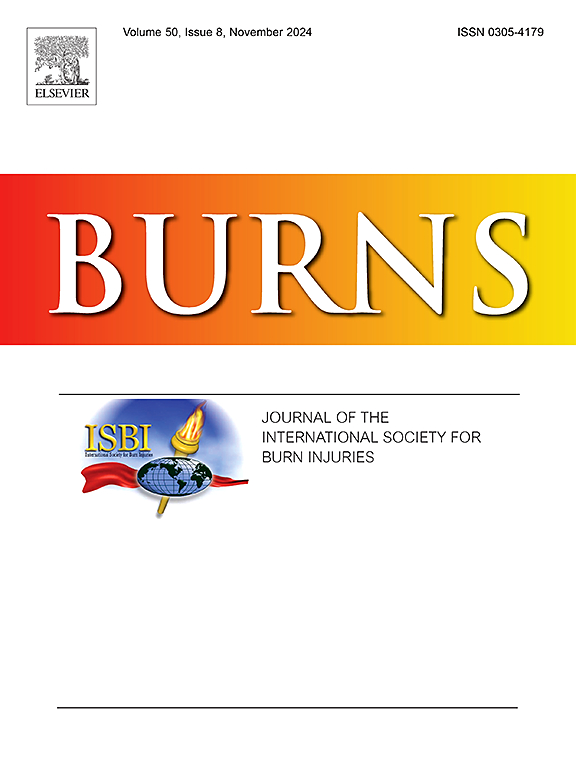Do burn injury prevention interventions change what people know and how people think? A systematic review investigating the impact on psychological constructs
IF 3.2
3区 医学
Q2 CRITICAL CARE MEDICINE
引用次数: 0
Abstract
Introduction
Burns can result in life-long physical and psychological difficulties. Interventions aimed at preventing burns are therefore important. Behaviour change theories propose that psychological variables (e.g., knowledge, attitudes, beliefs, self-efficacy) are associated with injury prevention behaviour. However, whether or not burn prevention interventions impact psychological variables is uncertain. This systematic review aimed to address this gap in the literature.
Methods
A systematic review was conducted according to PRISMA guidelines. Electronic databases (CINAHL, MEDLINE, PubMed and Scopus) were searched for randomized control trials (RCTs) of burn prevention interventions which measured at least one psychological construct. Studies were quality assessed using the Effective Public Health Practice Project (EPHPP) quality assessment tool.
Results
Eight studies met inclusion criteria. A narrative synthesis was conducted. Seven RCTs detailed interventions aimed at reducing paediatric burns (five delivered to parents/caregivers and two delivered to children). One RCT was aimed at adults. All RCTs measured burns knowledge, but findings were mixed about whether knowledge changed following interventions. Four RCTs measured self-efficacy, with all finding an increased perceived ability to engage in burn prevention behaviour following interventions. Risk perceptions (e.g., around the perceived severity and susceptibility of burns) were rarely measured.
Conclusion
To date, burn prevention RCTs have mainly focused on paediatric burns and most often measured knowledge change. However, the impact of interventions on knowledge is variable. Future burn prevention interventions should measure a range of psychological constructs, as these are likely to be important in burn prevention behaviour.
烧伤预防干预会改变人们的认知和思维吗?研究对心理构念影响的系统综述
烧伤会导致终生的身体和心理上的困难。因此,旨在预防烧伤的干预措施非常重要。行为改变理论提出,心理变量(如知识、态度、信念、自我效能)与伤害预防行为有关。然而,预防烧伤干预是否影响心理变量是不确定的。本系统综述旨在解决文献中的这一空白。方法根据PRISMA指南进行系统评价。电子数据库(CINAHL, MEDLINE, PubMed和Scopus)检索了至少测量一种心理结构的烧伤预防干预的随机对照试验(rct)。使用有效公共卫生实践项目(EPHPP)质量评估工具对研究进行质量评估。结果8项研究符合纳入标准。进行了叙事综合。7项随机对照试验详细介绍了旨在减少儿科烧伤的干预措施(5项给父母/照顾者,2项给儿童)。一项随机对照试验针对成人。所有的随机对照试验都测量了对烧伤的认知,但是关于认知是否在干预后发生变化的研究结果是混杂的。四项随机对照试验测量了自我效能感,均发现干预后参与烧伤预防行为的感知能力有所提高。风险感知(例如,围绕烧伤的感知严重程度和易感性)很少被测量。结论迄今为止,烧伤预防随机对照试验主要集中在儿科烧伤,最常测量的是知识变化。然而,干预措施对知识的影响是可变的。未来的烧伤预防干预措施应该测量一系列的心理结构,因为这些可能在烧伤预防行为中很重要。
本文章由计算机程序翻译,如有差异,请以英文原文为准。
求助全文
约1分钟内获得全文
求助全文
来源期刊

Burns
医学-皮肤病学
CiteScore
4.50
自引率
18.50%
发文量
304
审稿时长
72 days
期刊介绍:
Burns aims to foster the exchange of information among all engaged in preventing and treating the effects of burns. The journal focuses on clinical, scientific and social aspects of these injuries and covers the prevention of the injury, the epidemiology of such injuries and all aspects of treatment including development of new techniques and technologies and verification of existing ones. Regular features include clinical and scientific papers, state of the art reviews and descriptions of burn-care in practice.
Topics covered by Burns include: the effects of smoke on man and animals, their tissues and cells; the responses to and treatment of patients and animals with chemical injuries to the skin; the biological and clinical effects of cold injuries; surgical techniques which are, or may be relevant to the treatment of burned patients during the acute or reconstructive phase following injury; well controlled laboratory studies of the effectiveness of anti-microbial agents on infection and new materials on scarring and healing; inflammatory responses to injury, effectiveness of related agents and other compounds used to modify the physiological and cellular responses to the injury; experimental studies of burns and the outcome of burn wound healing; regenerative medicine concerning the skin.
 求助内容:
求助内容: 应助结果提醒方式:
应助结果提醒方式:


